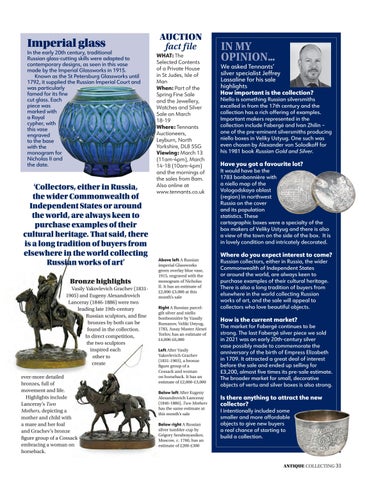Imperial glass
In the early 20th century, traditional Russian glass-cutting skills were adapted to contemporary designs, as seen in this vase made by the Imperial Glassworks in 1915. Known as the St Petersburg Glassworks until 1792, it supplied the Russian Imperial Court and was particularly famed for its fine cut glass. Each piece was marked with a Royal cypher, with this vase engraved to the base with the monogram for Nicholas II and the date.
‘Collectors, either in Russia, the wider Commonwealth of Independent States or around the world, are always keen to purchase examples of their cultural heritage. That said, there is a long tradition of buyers from elsewhere in the world collecting Russian works of art’ Bronze highlights Vasily Yakovlevich Grachev (18311905) and Eugeny Alexandrovich Lanceray (1846-1886) were two leading late 19th-century Russian sculptors, and fine bronzes by both can be found in the collection. In direct competition, the two sculptors inspired each other to create ever-more detailed bronzes, full of movement and life. Highlights include Lanceray’s Two Mothers, depicting a mother and child with a mare and her foal and Grachev’s bronze figure group of a Cossack embracing a woman on horseback.
AUCTION fact file
WHAT: The Selected Contents of a Private House in St Judes, Isle of Man When: Part of the Spring Fine Sale and the Jewellery, Watches and Silver Sale on March 18-19 Where: Tennants Auctioneers, Leyburn, North Yorkshire, DL8 5SG Viewing: March 13 (11am-4pm), March 14-18 (10am-4pm) and the mornings of the sales from 8am. Also online at www.tennants.co.uk
Above left A Russian
imperial Glassworks green overlay blue vase, 1915, engraved with the monogram of Nicholas II. It has an estimate of £2,000-£3,000 at this month’s sale Right A Russian parcel-
gilt silver and niello bonbonnière by Vassily Romanov, Veliki Ustyug, 1783, Assay Master Alexei Torlov, has an estimate of £4,000-£6,000 Left After Vasily
Yakovlevich Grachev (1831-1905), a bronze figure group of a Cossack and woman on horseback. It has an estimate of £2,000-£3,000 Below left After Eugeny Alexandrovich Lanceray (1846-1886), Two Mothers has the same estimate at this month’s sale Below right A Russian
silver tumbler-cup by Grigory Serabrayanikov, Moscow, c. 1760, has an estimate of £200-£300
IN MY OPINION...
We asked Tennants’ silver specialist Jeffrey Lassaline for his sale highlights How important is the collection?
Niello is something Russian silversmiths excelled in from the 17th century and the collection has a rich offering of examples. Important makers represented in the collection include Fabergé and Ivan Zhilin – one of the pre-eminent silversmiths producing niello boxes in Veliky Ustyug. One such was even chosen by Alexander von Solodkoff for his 1981 book Russian Gold and Silver.
Have you got a favourite lot?
It would have be the 1783 bonbonnière with a niello map of the Vologodskaya oblast (region) in northwest Russia on the cover and its population statistics. These cartographic boxes were a specialty of the box makers of Veliky Ustyug and there is also a view of the town on the side of the box. It is in lovely condition and intricately decorated.
Where do you expect interest to come? Russian collectors, either in Russia, the wider Commonwealth of Independent States or around the world, are always keen to purchase examples of their cultural heritage. There is also a long tradition of buyers from elsewhere in the world collecting Russian works of art, and the sale will appeal to collectors who love beautiful objects.
How is the current market?
The market for Fabergé continues to be strong. The last Fabergé silver piece we sold in 2021 was an early 20th-century silver vase possibly made to commemorate the anniversary of the birth of Empress Elizabeth in 1709. It attracted a great deal of interest before the sale and ended up selling for £3,200, almost five times its pre-sale estimate. The broader market for small, decorative objects of vertu and silver boxes is also strong.
Is there anything to attract the new collector? I intentionally included some smaller and more affordable objects to give new buyers a real chance of starting to build a collection.
ANTIQUE COLLECTING 31



